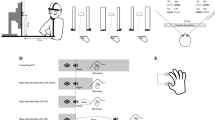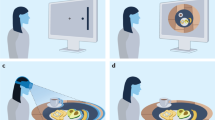Abstract
When reaching to objects, our hand and arm rarely collide with non-target objects, even if our workspace is cluttered. The simplicity of these actions hides what must be a relatively sophisticated obstacle avoidance system. Recent studies on patients with optic ataxia and visual form agnosia have demonstrated that obstacle avoidance is an automatic process, likely governed by the dorsal stream (Schindler et al. 2004; Rice et al. 2006). The current study sought to quantify how normal participants react to changes in the size and position of non-target objects in and around their workspace. In the first experiment, 13 right-handed subjects performed reaches to a target strip in the presence of two non-target objects, which varied in depth and horizontal configuration. We found that objects with horizontal alignments that were asymmetric about midline created systematic deviations in reach trajectory away from midline, with participants seeming to maximize the distance away from the two objects. These deviations were significantly greater for objects nearer in depth and nearly disappeared when the objects were placed beyond the target strip. Accompanying this pattern of deviation were other significant obstructing effects whereby reaches were executed more slowly when objects were close in depth and close to the participants reaching (right) hand. In the second experiment, we varied the height of the two objects, as well as the depth. Object pairs were now both tall, both short, or one-short/one-tall. We replicated the significant depth effects of the first experiment, extending the finding to include sensitivity to the size of the objects. Here the obstructing effect caused by short objects was similar to tall objects when those objects were placed at the depth of the reach target, but less than the tall objects when placed at mid-reach. Taken together, these experiments suggest that humans possess a sophisticated obstacle avoidance system that is extremely sensitive and conservative in evaluating potential obstacles and adjusting the reach accordingly.





Similar content being viewed by others
References
Bridgeman B, Peery S, Anand S (1997) Interaction of cognitive and sensorimotor maps of visual space. Percept Psychophys 59(3):456–469
Castiello U (1996) Grasping a fruit: selection for action. J Exp Psychol Hum Percept Perform 22(3):582–603
Castiello U (1999) Mechanisms of selection for the control of hand action. Trends Cogn Sci 3(7):264–271
Castiello U (2001) The effects of abrupt onset of 2-D and 3-D distractors on prehension movements. Percept Psychophys 63(6):1014–1025
Diedrichsen J, Werner S, Schmidt T, Trommershauser J (2004) Immediate spatial distortions of pointing movements induced by visual landmarks. Percept Psychophys 66(1):89–103
Goodale MA, Milner AD (1992) Separate visual pathways for perception and action. Trends Neurosci 15(1):20–25
Goodale MA, Milner AD, Jakobson LS, Carey DP (1991) A neurological dissociation between perceiving objects and grasping them. Nature 349(6305):154–156
Howard LA, Tipper SP (1997) Hand deviations away from visual cues: indirect evidence for inhibition. Exp Brain Res 113(1):144–152
Jackson SR, Jackson GM, Rosicky J (1995) Are non-relevant objects represented in working memory? The effect of non-target objects on reach and grasp kinematics. Exp Brain Res 102(3):519–530
James TW, Culham J, Humphrey GK, Milner AD, Goodale MA (2003) Ventral occipital lesions impair object recognition but not object-directed grasping: an fMRI study. Brain 126(Pt 11):2463–2475
McIntosh RD, McClements KI, Dijkerman HC, Birchall D, Milner AD (2004a) Preserved obstacle avoidance during reaching in patients with left visual neglect. Neuropsychologia 42(8):1107–1117
McIntosh RD, McClements KI, Schindler I, Cassidy TP, Birchall D, Milner AD (2004b) Avoidance of obstacles in the absence of visual awareness. Proc Biol Sci 271(1534):15–20
Milner AD, McIntosh RD (2004) Reaching between obstacles in spatial neglect and visual extinction. Prog Brain Res 144:213–226
Milner AD, Perrett DI, Johnston RS, Benson PJ, Jordan TR, Heeley DW et al (1991) Perception and action in ‘visual form agnosia’. Brain 114(Pt 1B):405–428
Mon-Williams M, Tresilian JR, Coppard VL, Carson RG (2001) The effect of obstacle position on reach-to-grasp movements. Exp Brain Res 137(3–4):497–501
Obhi SS, Goodale MA (2005) The effects of landmarks on the performance of delayed and real-time pointing movements. Exp Brain Res 167(3):335–344
Perenin MT, Vighetto A (1988) Optic ataxia: a specific disruption in visuomotor mechanisms. I. Different aspects of the deficit in reaching for objects. Brain 111(Pt 3):643–674
Rice NJ, McIntosh RD, Schindler I, Mon-Williams M, Demonet JF, Milner AD (2006) Intact automatic avoidance of obstacles in patients with visual form agnosia. Exp Brain Res 174(1):176–188
Rossetti Y, Revol P, McIntosh R, Pisella L, Rode G, Danckert J et al (2005) Visually guided reaching: bilateral posterior parietal lesions cause a switch from fast visuomotor to slow cognitive control. Neuropsychologia 43(2):162–177
Schindler I, Rice NJ, McIntosh RD, Rossetti Y, Vighetto A, Milner AD (2004) Automatic avoidance of obstacles is a dorsal stream function: evidence from optic ataxia. Nat Neurosci 7(7):779–784
Tipper SP, Howard LA, Jackson SR (1997) Selective reaching to grasp: evidence for distractor interference effects. Vis Cogn 4(1):1–38
Tipper SP, Lortie C, Baylis GC (1992) Selective reaching: evidence for action-centered attention. J Exp Psychol Hum Percept Perform 18(4):891–905
Tipper SP, Meegan DV, Howard LA (2002) Action-centered negative priming: evidence for reactive inhibition. Vis Cogn 9(4):591–614
Tresilian JR (1998) Attention in action or obstruction of movement? A kinematic analysis of avoidance behavior in prehension. Exp Brain Res 120(3):352–368
Tresilian JR (1999) Selective attention in reaching: when is an object not a distractor? Trends Cogn Sci 3(11):407–408
Tresilian JR, Mon-Williams M, Coppard VL, Carson RG (2005) Developmental changes in the response to obstacles during prehension. J Mot Behav 37(2):103–110
Author information
Authors and Affiliations
Corresponding author
Electronic supplementary material
Below is the link to the electronic supplementary material.
Rights and permissions
About this article
Cite this article
Chapman, C.S., Goodale, M.A. Missing in action: the effect of obstacle position and size on avoidance while reaching. Exp Brain Res 191, 83–97 (2008). https://doi.org/10.1007/s00221-008-1499-1
Received:
Accepted:
Published:
Issue Date:
DOI: https://doi.org/10.1007/s00221-008-1499-1




